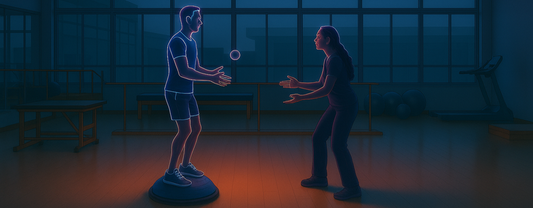Blog Posts
Our blog is a resource for clinicians, patients, and anyone interested in advancing rehabilitation. Explore expert insights, practical guides, and the latest research on brain health, movement, and recovery, all designed to support better outcomes and clearer progress.
News

The Origin of HeadX
The idea for HeadX came from a weekend that had nothing to do with physiotherapy or technology sales, but everything to do with possibility. A few years ago, I joined...
The Origin of HeadX
The idea for HeadX came from a weekend that had nothing to do with physiotherapy or technology sales, but everything to do with possibility. A few years ago, I joined...

Dual Tasking in Vestibular Rehabilitation: Clin...
What is Dual Tasking? Dual tasking in vestibular rehabilitation refers to performing a vestibular or balance exercise while simultaneously engaging in a secondary task, typically cognitive or motor. It reflects...
Dual Tasking in Vestibular Rehabilitation: Clin...
What is Dual Tasking? Dual tasking in vestibular rehabilitation refers to performing a vestibular or balance exercise while simultaneously engaging in a secondary task, typically cognitive or motor. It reflects...

Understanding Kinesiophobia: Fear of Movement i...
Introduction Kinesiophobia, defined as the fear of movement or physical activity due to the belief that it may cause pain or re-injury, is increasingly recognised as a significant factor in...
Understanding Kinesiophobia: Fear of Movement i...
Introduction Kinesiophobia, defined as the fear of movement or physical activity due to the belief that it may cause pain or re-injury, is increasingly recognised as a significant factor in...

Cervical Control and Post-Stroke Rehabilitation...
Beyond Limb Recovery Stroke rehabilitation often concentrates on the recovery of strength and limb function, but this focus sometimes obscures the quieter, less obvious challenges that survivors face. Alongside weakness...
Cervical Control and Post-Stroke Rehabilitation...
Beyond Limb Recovery Stroke rehabilitation often concentrates on the recovery of strength and limb function, but this focus sometimes obscures the quieter, less obvious challenges that survivors face. Alongside weakness...

Concussion Impairments and Rehabilitation: A Gu...
Concussion is more than a short-term head injury—it can disrupt vision, balance, thinking, mood, and even the body’s tolerance to exercise. This guide explains the seven most common post-concussion impairments,...
Concussion Impairments and Rehabilitation: A Gu...
Concussion is more than a short-term head injury—it can disrupt vision, balance, thinking, mood, and even the body’s tolerance to exercise. This guide explains the seven most common post-concussion impairments,...

Understanding Vestibular Disorders and Dizzines...
Dizziness is one of the most common and unsettling complaints in healthcare, accounting for a significant number of GP visits and specialist referrals each year. It can appear suddenly after...
Understanding Vestibular Disorders and Dizzines...
Dizziness is one of the most common and unsettling complaints in healthcare, accounting for a significant number of GP visits and specialist referrals each year. It can appear suddenly after...
